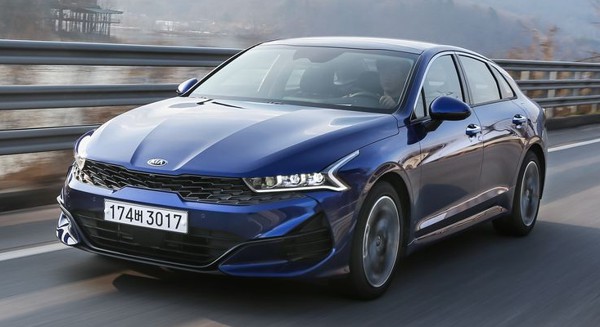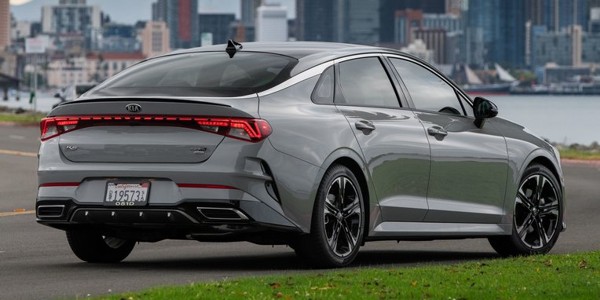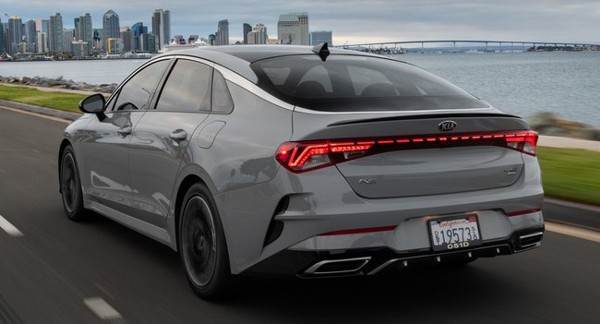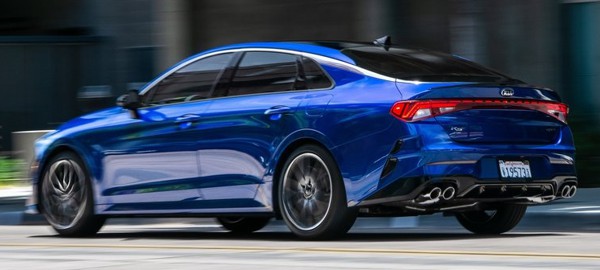Published
on 31
Oct 2020
|
All rights reserved.
|
|
|

|
|
New
K5 pushes design to another level.
|
|
It is fair to say
Hyundai-Kia group is right at the top of the game in terms of design,
thanks to the help of ex-Volkswagen group designer Peter Schreyer.
Since his arrival in 2006, Kia, and then Hyundai, moved up quickly in
the design field, building a reputation for elegance and creativity,
and it goes from strength to strength in recent years. Today, while
Mercedes, Renault and Peugeot are also praised for great designs, it is
Hyundai-Kia group that really amazes car enthusiasts with high-quality
designs that spread across a wide variety of segments and brands. In
short, it is doing the best job in the motor industry.
We praised the styling of the last 2 generations Kia K5 / Optima, but
that doesn’t prevent the company from taking another giant step
forward. The new K5, now having dropped its American name Optima, is
easily the most stylish car in the D-segment family car class. You
think Toyota Camry, Mazda 6 or even the new Hyundai Sonata stylish?
Turn to the new K5 and you’ll see how it pushes design to another level
! The long and curvy hood delivers a rear-wheel-drive proportion (which
is not, of course). The zigzag headlights are stylish. The fastback
silhouette replicates the sportiness of Stinger, even though it is
actually a sedan. Clever use of chrome stripes at the roof rails,
rectangular chromed exhausts, pseudo diffusers and a very graphical LED
taillight stripe highlighting an energetic, dynamic and smart
personality. It makes other cars in the segment suddenly look outdated.

|
|
It
has some Stinger from the rear view, although it is still a front-wheel
drive sedan.
|
|
Frankly, you don’t buy family sedans just for looks, otherwise Toyota
Camry would not have topped the segment for decades. A blend of space,
equipment, comfort and value are essential to family car buyers. Open
the doors of the new K5, you will find the interior quite inviting. No,
it is not a Mercedes A-class, but for an affordable mainstream sedan,
there is really nothing to complain about. While there are some hard
plastics displayed on door panels etc., most prominent surfaces and
touch points are soft materials. The dashboard architecture shares with
sister car Sonata, as are some switch gears if you notice, but the
packaging is all new. The digital instrument looks modern. The
touchscreen is mounted high for easy reading. However, it is
recommended to upgrade to the 10.3-inch item shown in picture, as it
comes with crisper graphics. Some physical controls have been
sacrificed in the presence of larger touchscreen, but at least the
infotainment system software is intuitive and responsive. Elsewhere,
the K5’s cabin is roomy, as the new car has grown considerably,
including 45mm in wheelbase. Rear seat is good for six-footers, with
generous legroom especially. The sloping back doesn’t hurt headroom as
much as expected. The driver seat is comfortable and highly adjustable,
although it cannot be lowered enough for keen drivers.

|
|
Roomy and
nicely finished interior.
|
|
The engine range of this K5 has been simplified. Most people will
settle with the new Gamma II 1.6-liter T-GDI direct injection turbo
that debuted on Sonata. Unlike the old 1591c.c. unit, this 1598c.c.
unit has a 350 bar (instead of 200 bar) fuel injection and, most
importantly, a world’s first CVVD continuous variable valve duration
mechanism that is said to improve fuel consumption by 5 percent and
performance by 4 percent. That said, its output, i.e. 180hp and 195
lbft from 1500 rpm, doesn’t set any new standards. While drivability is
good and performance is more than adequate, it suffers from more noise
at higher revs. On the plus side, the 8-speed automatic gearbox works
in harmony with the engine.
If you ask the powertrain for more, you might find the manual override
of the 8-speeder a bit slow to respond to your inputs. In general, the
K5 is not designed for keen drivers, unlike Honda Accord or Mazda 6.
Even if the upcoming GT model, which employs a 2.5-liter four-cylinder
turbo good for 290 horsepower, could solve the performance problem, I
suspect its chassis is not up to the task of a sports sedan. Again, the
Kia shares a platform with Hyundai Sonata, now known as N3. It rides on
MacPherson struts up front and multi-link suspensions at the rear. No
adaptive dampers are OK for the class, but the chassis seems not
designed to take on challenging driving. The suspension setting is
soft, focusing on delivering comfortable ride and good running
refinement. That mission is mostly accomplished, although if you opt
for 18-inch wheels to fully fill the large wheel arches, you will
experience more noise and coarseness than desired from the pavement.
There are more refined cars elsewhere.
 |
|
Driving
dynamics are no more than average, while refinement could be hampered
by larger wheels.
|
|
On the flipside, the K5 shows moderate body roll through corners. Its
turn-in response is quite slow. Grip is just average, despite 235
tires. The steering is heavy but numb in feel. The brake pedal is soft.
Yes, all these problems could be solved by tuning, especially if Albert
Biermann gives a helping hand, but the base car’s lack of driver appeal
is not a good sign for the upcoming GT. It shows that the engineering
team has different priorities, i.e. space, comfort, equipment, value…
all the traditional core values of family cars. Sadly, this prevents
the K5 to break its own mold and elevate into the class leader level.
If you love driving, Stinger is still the car to have.
|
Verdict:     |
Published
on 3
Mar 2021
|
All rights reserved.
|
|
K5 GT
|
|

|
|
More
power than its chassis capable to cope with.
|
|
Sharing the same
underpinnings with Hyundai Sonata N-line, including the 2.5-liter
turbocharged four-cylinder engine with 290 horsepower as well as an
8-speed dual-clutch gearbox, Kia K5 GT has the same pros and cons. On
the plus side, it is quick for a performance family sedan. Well, not
quite as quick as a BMW M340i, Audi S4 or Kia’s own Stinger GT V6, but
it outruns anything in the same price bracket, such as Honda Accord
2.0T, Toyota Camry V6 and Nissan Maxima. It takes just over 5 seconds
to go from rest to 60 mph, and a tad over 12 seconds to the ton. Even
Detroit metal cannot quite rival it for performance per buck. A Dodge
Charger R/T with 5.7 V8 matches its performance, but asks for an extra
5000 bucks. Starting from $31,500, the K5 GT is a performance bargain,
more so than its Hyundai sister.
On the flipside, the Kia has more power than its chassis capable to
cope with – just the same as Hyundai. To enable the lowish price, it
ignores the need of an LSD or 4-wheel-drive hardware. As a result,
unleashing too much power too early in a corner will trigger wheelspin
in any gears, and you are always fighting with torque steer in the
process. While the Kia’s horsepower is no higher than some FWD hot
hatches, its superior torque from the 2.5-liter engine, i.e. 311 lbft
from as low as 1650 rpm, makes it all the more difficult to tame, let
alone for a chassis with an open differential. As we always say, power
alone is meaningless, what matter is how much power you can put to the
ground. In the Kia’s case, it is a failure.
Apart from engine, the K5 GT has other performance upgrades: stiffer
suspension setup and harder bushings, larger brakes and 19-inch wheels
shod with 245/40 Pirelli P-Zeros. It is a nice setup, giving adequate
body control. However, without taming that torque steer and wheelspin,
you need to drive with absolute discipline – not something a keen
driver hopes for. Even if you can avoid optimistic use of throttle, you
will find the car approaches fast corner with terminal understeer
rather than the neutrality of a BMW 3-Series or the tire-burning
sideway of a Dodge Charger Scat Pack. If driving excitement is the main
reason you buy a powerful family sedan, you should look for a
rear-drive alternative.
The K5 GT is not without its attraction. Such a bargain price buys you
not only power but also a stylish, well-built and comfortable package.
It is a lot of car for the money, and that's why it still earns 3 stars
rating. However, if you could spend more, you should definitely upgrade
to a Stinger GT, whose rear-drive chassis offers a completely new
dimension of driving excitement.
|
Verdict:    |
|